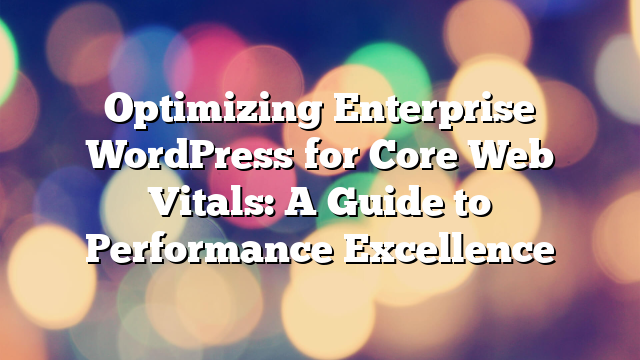Optimizing Enterprise WordPress for Core Web Vitals: A Guide to Performance Excellence
26.04.2025

As Google continues to prioritize user experience, Core Web Vitals have become critical indicators of website performance. For enterprise websites running on WordPress, meeting these benchmarks is essential not only for SEO but also for user satisfaction, conversion rates, and brand credibility. In this article, we’ll explore how enterprise teams can optimize their WordPress platforms to exceed Core Web Vitals standards.
Understanding Core Web Vitals
Core Web Vitals focus on three key performance metrics:
- Largest Contentful Paint (LCP): Measures loading performance. LCP should occur within 2.5 seconds of when the page first starts loading.
- First Input Delay (FID): Gauges interactivity. Pages should have an FID of less than 100 milliseconds.
- Cumulative Layout Shift (CLS): Evaluates visual stability. CLS should be less than 0.1 to ensure smooth visual flow.
Why Core Web Vitals Matter for Enterprise Sites
Enterprise websites typically carry significant content, media, and traffic, all of which can strain performance. A few milliseconds of delay in load time or interaction can cause drop-offs in user engagement and search engine rankings. For large-scale businesses, this translates into lost opportunities and revenue.
Enterprise-Ready Optimization Strategies
Here are some of the most effective ways to optimize your WordPress website for Core Web Vitals:
1. Use a Headless WordPress Architecture
Decoupling the frontend from the backend allows enterprises to use blazing-fast frontend frameworks like Next.js or Nuxt.js while still managing content in WordPress. This setup significantly improves loading times and overall performance.
2. Implement Advanced Caching
Leverage object caching with Redis or Memcached and deploy full-page caching using solutions like Varnish or server-level caching from providers like NGINX or LiteSpeed. This reduces server load and speeds up page delivery.
3. Optimize Hosting Infrastructure
Choose enterprise-grade hosting platforms optimized for WordPress, with features like CDN integration, auto-scaling, and dedicated resources. Managed WordPress hosts can also provide Core Web Vitals monitoring and proactive performance tuning.
4. Fine-Tune Theme and Plugins
Use a lightweight, modular theme and audit all plugins for performance impact. Custom-built themes and plugins often outperform bloated third-party solutions, especially at scale.
5. Lazy Load and Compress Media
Use modern image formats like WebP, implement lazy loading, and serve assets through a CDN. This improves LCP without sacrificing visual quality.
Monitoring and Continuous Improvement
Enterprise teams should continuously monitor Core Web Vitals using tools like Google PageSpeed Insights, Lighthouse, and real user monitoring (RUM) solutions. Integrating these checks into your CI/CD pipeline ensures performance remains a top priority with every deployment.
Conclusion
Optimizing for Core Web Vitals is no longer optional—it’s essential for enterprise websites looking to stay competitive in search and deliver exceptional user experiences. With a strategic approach to infrastructure, architecture, and development practices, WordPress can absolutely meet—and even exceed—these performance benchmarks.
Looking to take your enterprise WordPress performance to the next level? Vipe Studio specializes in custom, high-performance WordPress solutions tailored to large-scale businesses. Contact us today to learn how we can help.



